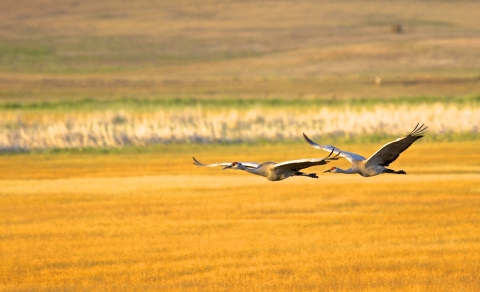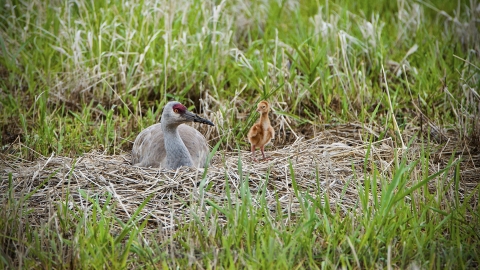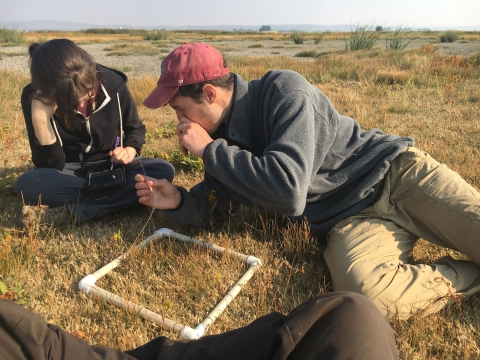What We Do
The refuge is working hard with a variety of partners to continually improve public lands for wildlife and people.
Management and Conservation
Water Management
Water is a nearly priceless resource for any landowner in the Great Basin, especially when the objective of the land is to provide habitat for wildlife, and even more so when the habitat is managed for waterbirds. Modoc NWR receives its water from four main sources. Those sources are the North Fork Pit River, South Fork Pit River, Parker Creek, and Pine Creek waterways. Water is stored through the winter in Dorris reservoir to be utilized in the summer and fall when water is most needed. Water is managed on the refuge in many ways to produce desired habitat. In most cases it is utilized to hydrate vegetation in wet meadow systems and wetlands, though in some circumstances it is actually removed from units during the growing season to grow desired wetland plants that produce valuable forage for waterfowl. In any case, water is the most important resource at Modoc NWR, and how it's managed has important consequences to the value of wildlife habitat.
Habitat Management
A variety of techniques are used to manage habitat at Modoc NWR. Through manipulation of water levels, prescribed burning, disking, mowing, seeding, and transplanting the Refuge strives to provide the most valuable habitat for wildlife.
Modoc NWR has a variety of habitat ranging from upland shrub communities, to seasonal and permanent wetlands, to expansive open water. Read below to learn more about the various habitats that compose the Refuge and why they are valuable to wildlife. Laying at an elevation of 4,365 feet, the refuge is situated near the confluence of the north and south forks of the Pit River. Modoc NWR lies just beyond the western edge of the Great Basin, with the Warner Mountain range on the east and the Adin Mountain range on the west. Several habitat types are represented: freshwater lakes and wetlands, farmland and irrigated meadows, sagebrush sagebrush
The western United States’ sagebrush country encompasses over 175 million acres of public and private lands. The sagebrush landscape provides many benefits to our rural economies and communities, and it serves as crucial habitat for a diversity of wildlife, including the iconic greater sage-grouse and over 350 other species.
Learn more about sagebrush upland and riparian riparian
Definition of riparian habitat or riparian areas.
Learn more about riparian corridors. In addition to the migratory bird populations, these diverse habitats support a wide range of other wildlife.
Semipermanent Wetlands and Seasonal Wetlands (1,966 acres)
Semipermanent and seasonal wetland habitats provide valuable resources for nearly every species at Modoc National Wildlife Refuge. The insects, seeds, and tubers are just a few of the food resources that wetlands provide for foraging wildlife. Thick wetland vegetation provides nesting cover during the spring and summer months, while acting as shelter during the harsher fall and winter months. In the arid Great Basin environment where Modoc NWR is found, these wetlands become even more valuable as water is a scarce resource. Preserving these wetland habitats is imperative to conserving the rich diversity of wildlife found in North America.
Wet Meadows (2,183 acres)
Irrigated wet meadows provide extraordinary habitat for a variety of species at Modoc NWR. Because these meadows are not often limited by water availability, they are composed of a rich variety of grasses, forbs, and sedges that provide forage and nesting cover for many bird species.
Farmed Fields (554 acres)
Agricultural grains provide crucial calories to migrating and wintering waterfowl. In addition, other birds and mammals forage on the grains and insects in the fields. The Refuge farms between 4 and 6 fields a year to provide this high-energy food source. When not in grain, some of the fields are flooded to provide supplemental wetland habitat, which also replenishes soil nutrients. The Refuge is in the process of converting the least productive grain fields back to native grasslands or seasonal wetlands.
Uplands (1,514 acres)
The Refuge uplands consist of a variety of grasses and forbs intermixed with sagebrush and rabbitbrush. Though very susceptible to weed invasion, this habitat provides valuable cover for nesting ducks, along with providing foraging opportunities for other birds, mammals, reptiles, and amphibians. The Refuge is constantly battling weeds in this habitat to foster the survival and expansion of the native plants.
Riparian (246 acres)
At Modoc NWR, riparian habitats provide valuable resources for birds, especially raptors and small song birds that forage and nest in the dense cover. The riparian habitat at the Refuge is made up almost entirely of Cottonwoods and Willows. Red-tailed hawks, great-horned owls, and western kingbirds are common summer residents found in riparian corridors, while bald eagles, red-shouldered hawks, and cedar waxwings use them throughout their migrations.
Invasive Weed Management
An important part of habitat management is controlling invasive weeds. Modoc NWR uses data collection, planting native or beneficial seeds, mechanical removal and chemical treatment of invasive weeds as part of the Refuge’s weed management program. Refuge staff collect spatial information about weed infestations on the Refuge and create detailed maps. These maps help managers track weed infestation stages and measure the progress of invasive species invasive species
An invasive species is any plant or animal that has spread or been introduced into a new area where they are, or could, cause harm to the environment, economy, or human, animal, or plant health. Their unwelcome presence can destroy ecosystems and cost millions of dollars.
Learn more about invasive species treatment.
Treatment of invasive species is essential to maintaining quality habitat for a variety of wildlife species that depend on Modoc NWR. Invasive weeds can take water and nutrients that would otherwise be available for native and beneficial plants. Some invasive weeds can excrete salt, making the ground around them toxic to other plants. The wildlife of Modoc rely on a mosaic of habitat types available at Modoc NWR, which are maintained by our robust weed management program.
Refuge Planning
National Wildlife Refuge planning sets the broad vision for refuge management and the goals, objectives, strategies, and actions required to achieve it. Planning ensures that each refuge meets its individual purposes, contributes to the Refuge System’s mission and priorities, is consistent with other applicable laws and policies, and enhances conservation benefits beyond refuge boundaries.
Comprehensive Conservation Plans
Comprehensive Conservation Plans (CCPs) are the primary planning documents for National Wildlife Refuges. As outlined in the National Wildlife Refuge System Administration Act, as amended, the U.S. Fish and Wildlife Service (Service) is required to develop CCPs that guide refuge management for the next 15 years. CCPs articulate the Service’s contributions to meeting refuge purposes and the National Wildlife Refuge System mission. CCPs serve as a bridge between broad, landscape-level plans developed by other agencies and stakeholders and the more detailed step-downs that stem from Refuge CCPs.
The 2009 Final Comprehensive Conservation Plan for Modoc National Wildlife Refuge can be found here: https://ecos.fws.gov/ServCat/Reference/Profile/1547
Step-down Plans
CCP step-down plans guide refuge-level programs for: (1) conserving natural resources (e.g., fish, wildlife, plants, and the ecosystems they depend on for habitat); (2) stewarding other special values of the refuge (e.g., cultural or archeological resources, wilderness, wild and scenic rivers, etc.); and (3) engaging visitors and the community in conservation, including providing opportunities for wildlife-dependent recreation. Like CCPs, step-down plans contribute to the implementation of relevant landscape plans by developing SMART (Specific, Measurable, Achievable, Relevant, and Time-bound) objectives, strategies, implementation schedules, and decision support tools to fulfill refuge visions and goals. This ensures that refuges are managed in a landscape context and that conservation benefits extend beyond refuge boundaries.
Our Services
If you are interested in a special use permit, please contact us. Of course, not all projects qualify for assistance, but contacting us is the first step.
To better accomplish our land management objectives, we sometimes utilize agricultural practices to manage and enhance habitat for wildlife. If you are interested in grazing livestock or harvesting hay on National Wildlife Refuge lands, please check here for available opportunities.
Our Projects and Research
Learn more about our recent and ongoing projects below:
Crane Banding
Modoc National Wildlife Refuge is a stopover for many species of migrating waterfowl and birds of the Pacific Flyway, including Sandhill cranes. There are 2 main subspecies of Sandhill cranes in the Pacific Flyway, the Greater and Lesser Sandhill crane. At Modoc NWR we see both subspecies as they migrate through but some of the Greater Sandhill cranes stay for the summer. The cranes that stay at Modoc NWR pick and defend territories to nest and raise young. The young cranes, called colts, usually hatch in June and July and are watched very closely by refuge staff. Approximately 4 to 6 weeks after hatching, the colts are larger, likely to survive but can’t yet fly. This is when refuge staff attempt to capture the colt and band it with a variety of plastic, colored bands easily distinguished from a distance.
Greater Sandhill crane banding started at Modoc NWR in the mid 1980’s. With a few exceptions, many of the cranes banded on or near the refuge were banded as colts. When the cranes return, the bright combination of bands allow observers to identify the individual birds. This data has helped managers understand the crane’s extreme site fidelity (the tendency to return to a previously occupied space).
Visitors interested in seeing cranes should plan their visit sometime between March and September. The largest numbers of both Greater and Lesser Sandhill cranes are observed during the migration, March & April and August & September. Greater Sandhill cranes can be seen on territory and occasionally on a nest from April to June. Colts can be seen anytime from June to August. The auto tour drive is often the best place to see not only cranes but also ducks, shorebirds, coyotes, turtles and lots of other wildlife.
Wetland Habitat Assessment Protocol (WHAP)
A collaboration between the U.S. Fish and Wildlife Service and University of California, Davis has created a new survey for refuge managers to estimate how well the refuge meet the nutritional needs of waterfowl on refuges. Starting in 2020, Modoc National Wildlife Refuge is collecting annual data on food-plant seed production. The Wetland Habitat Assessment Protocol, referred to as WHAP, is a multi-layered data collection tool that combines measuring seed heads and estimating plant densities. This information is then rolled into an estimate of grams of seeds per acre available to waterfowl as forage. The estimate of food produced is helpful for refuge managers who carefully plan the best ways to meet the needs of the waterfowl and other critters who rely on the refuge.
The WHAP focuses on 3 wetland food-plant species, swamp timothy, watergrass and lady’s thumb smartweed. The seeds from these plants are highly nutritious and sought after by ducks and geese on the refuge. For the last 2 summers, biologists and interns spent a week looking closely at the plants and seeds across the refuge. These photos show how a measurement is taken and what a fully seeded out plant looks like. Making sure migrating and wintering waterfowl have enough food to get them through their journey and the winter is one of the goals of Modoc NWR. This survey helps refuge staff gauge how well the refuge meets that goal.
Invasive Weed Mapping
An important aspect of habitat management is invasive weed control. As part of Modoc NWR's intensive weed control program, a large weed mapping project was completed in 2012. Ten of Modoc county's most invasive weeds were mapped on refuge lands. The final product is a series of very detailed maps illustrating refuge weed infestations. These maps will be valuable tools for refuge staff while planning weed control efforts and assessing the effectiveness of the weed control program.
Facts about invasive weeds
Invasive weeds compete with native plants and grasses for resources and often displace them entirely. Native wildlife relies on native plants for survival, so as native vegetation is replaced by invasives, there are major consequences for the associated wildlife.
Pit River Floodplain Project
In 2012 an exciting project was completed adding 80 acres to the floodplain of the south fork of the Pit River. In coordination with California Waterfowl Association and local contractors, the Refuge has completed a large project converting the “North Grain Field” into Pit River floodplain. The new floodplain area adds to the previous 120 acres to create 200 contiguous acres of floodplain wetlands, which provide valuable resources to a variety of nesting and migrating birds. The project created a new channel for the river, which now meanders through the previous “North Grain Field”, emulating historic conditions of the Pit River. Tule’s were transplanted from the existing floodplain and moist soil plants were seeded into the new floodplain to promote a quick transition to a diverse wetland complex. The Refuge and it’s partners in the project are excited to see the results after all the hard work. We encourage hunters to have a look at the project, but we caution them about deep mud that is expected throughout the project area. Anyone hunting within the floodplain should be very careful.
Early Signs Point to Success
Immediately after floodup of the new floodplain habitat, bird usage looked dismal. However, after new migrants arrived, bird usage soared, and over 2,500 ducks and geese were consistently seen foraging and loafing within the project area!
Wet Meadow Irrigation Improvement
More than 50 years of consistent irrigation of the Sharkey field at Modoc NWR had eroded ditches and created a very inefficient, and sometimes ineffective, irrigation regime. In 2012 this issue was confronted in cooperation with California Waterfowl Association and a local contracting crew. Sheet piling and rock dams were installed in more than 20 of the eroded ditches to hold up and disperse water at higher elevations. Also, many of the eroded ditches were filled with material to decrease the amount of water needed to irrigate the field. The project was a huge success, and this technique will continue to be used in the future to maximize the efficiency and effectiveness of irrigation in other wet meadows.
Facts about wet meadows:
Wet meadows are very important to wildlife, and provide excellent nesting habitat for Sandhill cranes, American bitterns, and rails. In the fall and spring, migrating white-fronted, Canada, and white geese forage on the fresh green shoots available in the meadows.
Refuge Island Enhancement
For a number of years the refuge has been working hard to improve islands for nesting and migrant birds. In the past, islands were built tall above the water, creating ideal conditions for weeds like poison hemlock, perennial pepperweed, and Canada thistle. Within many wetland units the refuge has scraped down these islands to remove the weed-promoting conditions and promote growth of desirable plants. In some cases the islands are left with sparse vegetation, and become excellent loafing sites for migrating birds. In other cases, the refuge has transplanted willows, tules, and other vegetation in order to provide nesting cover and natural food sources. There is an island with willows and tree snags that hunters may use for cover, and great growth of desirable wetland plants around the edges.
Facts about island enhancement:
Habitat restoration techniques and management practices are constantly changing as we learn more about the environment and the species that use it. Modoc NWR strives to stay on the cutting edge of restoration techniques so we can offer the best possible habitat. This often means changes to historical practices that no longer provide the best options.
Nest Box Project
Many nest boxes at Modoc NWR, which are important to a variety of cavity nesting birds, had fallen into disrepair. In 2012 refuge staff located all nest boxes on the refuge to assess box conditions and create a database to help future nest box management. The refuge now has a total of nearly 100 clean and sturdy nest boxes that cater to everything from swallows to owls!
Modoc is a Hoot!
Great horned owls are a year round resident of Modoc NWR, and can often be seen perched in cottonwoods or enjoying the shade under large sage brush.
Law Enforcement
Law enforcement is essential to virtually every aspect of wildlife conservation.
Laws and Regulations
Learn more about the laws and regulations related to hunting, fishing, visitation, and more.




